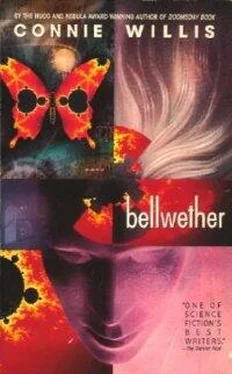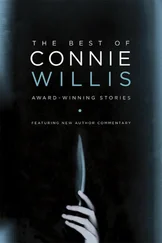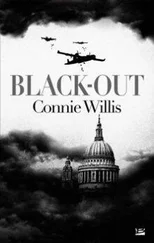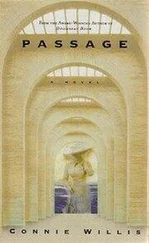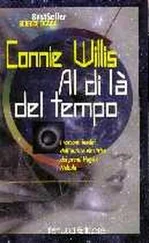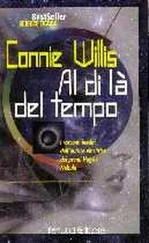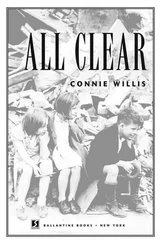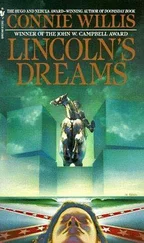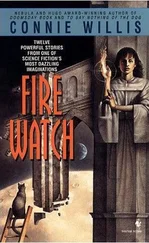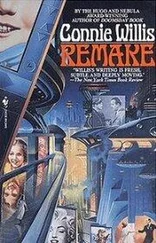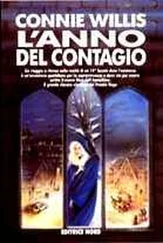“No,” I said. “Nebraska.”
This, on the other hand, was not. Alicia switched off the smile, said, “I have a lot of work to do,” and left without a backward glance. Whatever she’d wanted, apparently witty and messy weren’t enough.
I sat there staring at the screen wondering what that had been all about, and Flip came in wearing an assortment of duct tape and a pair of backless clogs.
She should have used some of the duct tape on the clogs. They slopped off her feet with every step, and she had to half-shuffle her way down the hall to me. The clogs and the duct tape were both the bilious electric blue she’d worn the other day.
“What do you call that color?” I asked.
“Cerenkhov blue.”
Of course. After the bluish radiation in nuclear reactors. How appropriate. In fairness, though, I had to admit it wasn’t the first time a faddish color had been given a wretched name. Back in Louis XVI’s day, color names had been downright nauseating. Sewerage, arsenic, smallpox, and Sick Spaniard had all been hit names for yellow-green.
Flip handed me a piece of paper. “You need to sign this,” she said.
It was a petition to declare the staff lounge a nonsmoking area. “Where will people be allowed to smoke if they can’t smoke in the lounge?” I said.
“They shouldn’t smoke. It causes cancer,” she said righteously. “I think people who smoke shouldn’t be allowed to have jobs.” She tossed her hank of hair. “And they should have to live someplace where their secondhand smoke can’t hurt the rest of us.”
“Really, Herr Goebbels,” I said, forgetting that ignorance is the biggest trend of all, and handed the petition back to her.
“Second-secondhand smoke is dangerous,” she said huffily.
“So is meanness.” I turned back to the computer.
“How much does a crown cost?” she said.
It seemed to be my day for questions out of left field. “A crown?” I said, bewildered. “You mean, like a tiara?”
“No-o-o,” she said. “A crown.”
I tried to picture a crown on top of Flip’s hank of hair, with her hair wrap hanging down one side, and failed. But whatever she was talking about, I’d better pay attention because it was likely to be the next big fad. Flip might be incompetent, insubordinate, and generally insufferable, but she was right there on the cutting edge of fashion.
“A crown,” I said. “Made out of gold?” I pantomimed placing one on my head. “With points?”
“Points?” she said, outraged. “It better not have points. A crown.”
“I’m sorry, Flip,” I said. “I don’t know—”
“You’re a scientist,” she said. “You’re supposed to know scientific terms.”
I wondered if crown had become a scientific term the way duct tape had become a personal errand.
“A crown!” she said, sighed enormously, and clopped out of the lab and down the hall.
It was my day for encounters I couldn’t make heads or tails of, and that included my hair-bobbing data. I was sorry I’d ever gotten the idea of including the other fads of the day. There were way too many of them, and none of them made any sense.
Peanut-pushing, for instance, and flagpole-sitting, and painting knees with rouge. College kids had painted old Model T’s with clever slogans like “Banana oil” and “Oh, you kid!”, middle-aged housewives had dressed up like Chinese maidens and played mah-jongg, and fads had seemed to come out of the woodwork, superseding each other in months and sometimes weeks. The black bottom replaced mah-jongg, which had replaced King Tut, and the whole thing was so chaotic it was impossible to sort out.
Crossword puzzles were the only fad that was halfway reasonable, and even that was a puzzle. The fad had started in the fall of 1924, well after hair-bobbing, but crossword puzzles had been around since the 1800s, and the New York World had published a weekly crossword since 1913.
And reasonable, on closer examination, wasn’t really the word. A minister had passed out crosswords during church that, on being solved, revealed the scripture lesson. Women had worn dresses decorated with black-and-white squares, and hats and stockings to match, and Broadway put on a revue called “Puzzles of 1925.” People had cited crosswords as the cause of their divorces, secretaries wore pocket dictionaries around their wrists like bracelets, doctors warned of eyestrain, and in Budapest a writer left a suicide note in the form of a crossword puzzle, a puzzle, by the way, which the police never solved, probably because they were already consumed with the next fad: the Charleston.
Bennett stuck his head in the door. “Have you got a minute? I need to ask you a question.” He came in. He had changed his checked shirt for a faded plaid one that was neither madras nor Ivy League, and he was carrying a copy of the simplified funding form.
“A two-letter word for an Egyptian sun god?” I said. “It’s Ra.”
He grinned. “No, I was just wondering if Flip had brought you a copy of the memo Management said they’d send around. Explaining the simplified funding form?”
“Yes and no,” I said. “I had to get one from Gina.” I fished it out from a pile of twenties books.
“Great,” he said, “I’ll go make a copy and bring this back.”
“That’s okay,” I said. “You can keep it.”
“You finished filling out your funding forms?”
“No,” I said. “Read the memo.”
He looked at it. “ ‘Page nineteen, Question forty-four-C. To find the primary extensional funding formula, multiply the departmental needs analysis by the fiscal base quotient, unless the project involves calibrated structuring, in which case the quotient should be calculated according to Section W-A of the accompanying instructions.’ ” He turned the paper over. “Where are the accompanying instructions?”
“No one knows,” I said.
He handed the memo back to me. “Maybe I don’t have to go to France to study chaos. Maybe I could study it right here,” he said, shaking his head. “Thanks,” and he started to leave.
“Speaking of which,” I said, “how’s your information diffusion project coming?”
“The lab’s all ready,” he said. “I can get the macaques as soon as I finish this stupid funding form, which should be in about”—he pulled a calculator out of his threadbare pants and punched in numbers—“six thousand years from now.”
Flip slouched in and handed us each a stapled stack of papers.
“What’s this?” Bennett said. “The accompanying instructions?”
“No-o-o,” Flip said, tossing her head. “It’s the FDA report on the health hazards of smoking.”
Dance marathon [1923–33]
Endurance fad in which the object was to dance the longest to earn money. Couples pinched and kicked each other to stay awake, and when that failed, took turns sleeping on their partner’s shoulder for as long as 150 days. The marathons became a gruesome spectator sport, with people watching to see who would have hallucinations brought on by sleep deprivation, collapse, or, in the case of Homer Moorhouse, drop dead, and the New Jersey SPCA complained that the marathons were cruel to (human) animals. Persisted into the first years of the Depression simply because people needed the money, which worked out to a little over a penny an hour. If you won.
Tuesday I met the new assistant interdepartmental communications liaison. I’d decided I couldn’t wait any longer for the accompanying instructions and was working on the funding forms when I noticed that the bottom of page 28 read, “List all,” and the top of the next page read, “to the diversification quotient.” I looked at the page number. It read “42.”
Читать дальше
